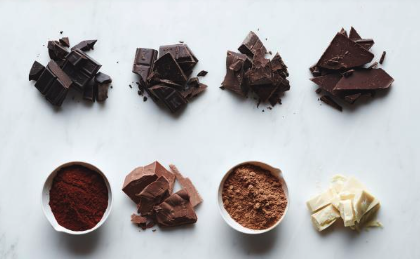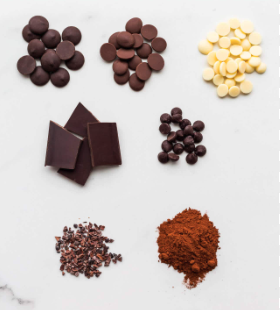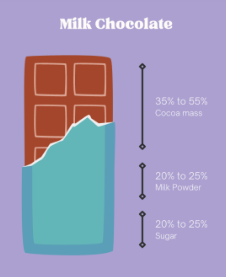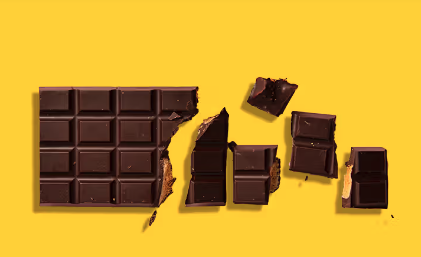High Cocoa Percents DO NOT Translate to High Quality
- Ethan Swift
- Aug 21, 2024
- 7 min read
Updated: Jan 15
Debunking Misconceptions...

Chocolate is one of the most beloved treats in the world, but determining chocolate quality can be challenging. One of the most common misconceptions is that the percentage of cocoa solids is the most critical factor in chocolate quality. In this article, we'll explore why this misconception exists, why it's incorrect, and what other factors to consider when evaluating chocolate quality.
Understanding Cocoa Percentage in Chocolate
Cocoa percentage refers to the amount of cocoa solids in chocolate, which ranges from 30% to 100%. Generally, higher cocoa percentages indicate a more intense chocolate flavor and bitterness. However, this metric doesn't always reflect chocolate quality. A lower cocoa percentage can still produce excellent chocolate, especially if it has a milder taste and sweeter flavor. Meanwhile, a high percentage of cocoa solids doesn't guarantee high-quality chocolate.
Common Misconception about Cocoa Percentage
Many people believe that high cocoa percentage means high-quality chocolate. However, this is a widespread misconception, as cocoa percentage alone doesn't reflect the other factors that contribute to chocolate quality. A high percentage of cocoa solids can still produce poor quality chocolate if the beans are of poor quality or have not been processed correctly. Additionally, some manufacturers add cocoa butter to increase the percentage of cocoa solids, but this doesn't necessarily improve the chocolate's quality.
Factors Affecting Chocolate Quality
To understand chocolate quality, it is essential to look beyond cocoa percentage and consider the many factors that contribute to it. Here are some of the critical factors:
Bean Quality: Chocolate quality starts with the beans. High-quality beans produce the best-tasting chocolate. Beans from different regions have distinct flavors, and factors such as origin, climate, and soil can significantly impact their quality. For example, Criollo beans, which are the rarest and most expensive, have a delicate flavor and aroma. In contrast, Forastero beans, which are the most common, are hardy and complex. And yes there are 33,000 + other rare varieties. I hope you weren't just going after criollo and thinking its just the best or the only real ceremonial cacao now...


Flavor can be a problem though... for example... world famous companies have tasters so advanced, they might not relate to the flavor as those do with an untrained palate. There is almost no way to tell and palate calibration seems like the only way and we assume its practiced. Companies like Ingemann's Fine Cacao have flavors like this but....to an untrained palate, those flavors won't be percievable. They are too reliant on the Mai lard Reaction, Seasonal Rainfalls and fermentation ph's, sugar, time and temperature to recreate accurately. Its impossible. Nice sales technique though. This also doesn't make sense because a chocolate-maker and expert sensory analyzers not only have the same skill set but they all are armed with a different set of taste buds and scent receptors in their nose. Its just like eyesight. There are no eye glasses for flavor though so it's impossible for flavor to be in 20/20 vision for everyone. Even peoples ability to express and communicate their experiences differ to such an extent that if would have one person taste everything, only once, their second experience (especially depending on palate fatigue will be completely different). You see chocolate breathes like wine. And the flavor changes more and more if its exposed to oxygen, to oxidize. Wine will become vinegar eventually because of oxygen! So after 15 minutes, chocolate will taste different if exposed to oxygen. After a day of oxidation it won't be recognizable! Keep in mind when people fridge their chocolates, they eliminate flavor, suppress and infuse it with whatever the fridge smells like. Read about that science here!
Processing
After the beans are harvested, they undergo processing, which involves several steps, such as fermenting, drying, roasting, and grinding. The way the beans are processed can affect the flavor and texture of the chocolate. Fermenting, for example, is a critical step that can reduce the bitterness of the beans and develop fruity and floral notes. Roasting can affect the chocolate's aroma and color, while grinding can affect its texture.
Heap fermentation is used in commodity cacao. So it's typically considered the least effective method (cacao requires 2-stage fermentation). So, makers cannot get consistent flavors. Thats 1.) why they started adding soured milk and 2.) they burn the beans at temperatures that are sub-optimally so high, every nuance and subtlety is unnoticeable and the flavor is 100% homogenized. Thats 70% of all chocolate that tastes exactly the same!1 To learn about quality fermentation, cacao to cocoa processing of any kind, and why the chocolate taste better, read this popular article!

Conching
Conching is the process of kneading and aerating the chocolate to develop its flavor and texture. This process can take anywhere from a few hours to several days. Longer conching times generally produce smoother, creamier chocolate with a richer, more complex flavor. Many of the world's finest chocolate makers conch their chocolate for several days, sometimes even up to a week. Currently, while writing this, Island Sharks is conching 10 lbs of 92% Cacao our newest flavor! The longer it runs, the more mellow it will be. So this needs to be mellowed because the nibs were so high quality. We made the nibs from beans we roasted, By Craftory. The wet beans were picked, shucked fermented and dried by the folks who make the chocolate for Island Sharks Chocolate. By Craftory is the fermentary for our area and yes we love supporting local farmers! By Craftory can buy wet buys for $4/lb. Pods are $0.70 each. If we pick your trees, we have a rate for harvesting and light pruning of your orchard. Cacao trees have a lot of little suckers, they grow, that sucks energy away from growing pods. They are called suckers. Here is a picture of some!
Blending
Most chocolate makers blend different bean varieties to achieve a unique flavor profile. Blending can also balance the acidity and bitterness of the chocolate. However, blending is a delicate process, and it requires expertise to achieve the desired flavor and texture.
Tempering

Tempering is the process of heating and cooling the chocolate to produce a glossy, smooth finish and a satisfying snap. Proper tempering can also prevent the chocolate from becoming grainy or developing a grayish-white discoloration known as bloom.
Ingredients: The ingredients in chocolate can also affect its quality. High-quality chocolate should have few ingredients, with cocoa solids, sugar, and possibly some additional flavorings, such as vanilla or sea salt. Avoid chocolate with artificial flavors or colors, as these can negatively affect the taste of the chocolate. Additionally, some manufacturers may add vegetable oils or other additives to their chocolate to cut costs or increase shelf life, which can result in a lower quality product. It's best to look for chocolate with a simple ingredients list and avoid those with added oils or other unnecessary ingredients. By choosing chocolate made with high-quality ingredients, you'll be able to fully appreciate the flavor and complexity of the chocolate. After you have tasted the chocolate, pay attention to its texture and mouthfeel. High-quality chocolate should have a smooth and creamy texture that melts in your mouth, and it should not leave a waxy or gritty feeling. The flavors should be well-balanced, with no single note dominating the others. Look for chocolate with a pleasant aroma and a long finish, as these are indications of high-quality chocolate.

When purchasing chocolate, be prepared to spend a little extra for high-quality chocolate. Artisanal chocolate makers often charge more for their products, but the extra cost is worth it for the superior flavor and quality. If you can, try to buy directly from the chocolate maker or a specialty chocolate shop that sources its chocolate from small-batch producers. By doing so, you can learn more about the chocolate's origin and production process and support smaller, sustainable chocolate producers.
While cocoa percentage is an important factor in determining chocolate quality, it is not the only one. A high percentage of cocoa solids does not necessarily mean high-quality chocolate, and there are many other factors to consider, such as bean quality, processing, and ingredients. To choose the best chocolate, look for high-quality beans, traditional processing methods, and natural ingredients. Consider the texture, flavor, and aroma of the chocolate, and be willing to spend a little extra for superior quality. By following these tips, you can experience the true depth and complexity of chocolate and discover new and exciting flavors and textures that you might have missed by only considering cocoa percentage.

Determining chocolate quality involves more than just looking at the percentage of cocoa solids. While cocoa percentage can give an indication of a chocolate's intensity and bitterness, it is only one of many factors that determine chocolate quality. Bean quality, processing, and other factors can greatly impact the flavor, texture, and overall experience of eating chocolate. When choosing high-quality chocolate, it's important to consider all these factors, including the ingredients used in the chocolate. By selecting chocolate with high-quality ingredients, a well-balanced flavor profile, and a smooth and creamy texture, you can fully appreciate the depth and complexity of chocolate.
Here is a list of unnecessary ingredients... You can make delicious chocolate without:
Lecithin, of any kind
Parafin Wax
Polyglycerol polyricinoleate
Artificial flavors or colors
Refined White Sugar
High Fructose Corn Syrup and Corn Syrup Solids: sweeteners from GMO corn
Vanillin: Synthetic substitute for natural vanilla (occurs naturally in cocoa as well)
Polyglycerol polyricinoleate. Clear as mud, right? Actually, PGPR is clear sludge.
TBHQ tert-Butylhydroquinone, is a food preservative most often used to extend the shelf life of unsaturated fats
These additives can negatively affect the taste of the chocolate and may indicate a lower-quality product. Some manufacturers may also add vegetable oils or other additives to cut costs or increase shelf life, but this can result in a less enjoyable chocolate experience. To fully appreciate the flavor and complexity of chocolate, it's best to choose chocolate with a simple ingredients list and avoid those with added oils or other unnecessary ingredients. By selecting high-quality chocolate made with simple, natural ingredients, you can savor the true richness and depth of this beloved treat.

















































Comments